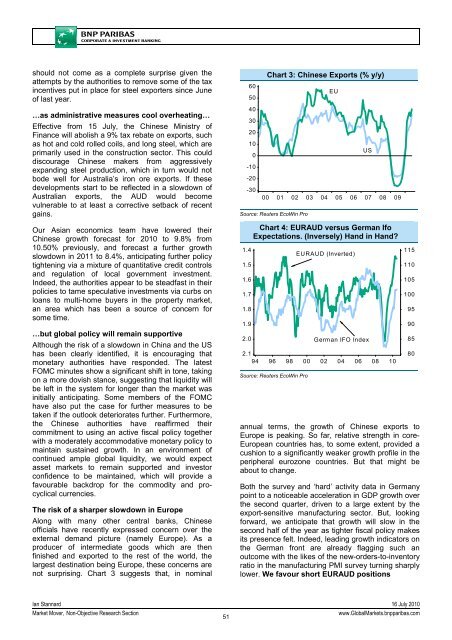Market Economics | Interest Rate Strategy - BNP PARIBAS ...
Market Economics | Interest Rate Strategy - BNP PARIBAS ...
Market Economics | Interest Rate Strategy - BNP PARIBAS ...
Create successful ePaper yourself
Turn your PDF publications into a flip-book with our unique Google optimized e-Paper software.
should not come as a complete surprise given the<br />
attempts by the authorities to remove some of the tax<br />
incentives put in place for steel exporters since June<br />
of last year.<br />
…as administrative measures cool overheating…<br />
Effective from 15 July, the Chinese Ministry of<br />
Finance will abolish a 9% tax rebate on exports, such<br />
as hot and cold rolled coils, and long steel, which are<br />
primarily used in the construction sector. This could<br />
discourage Chinese makers from aggressively<br />
expanding steel production, which in turn would not<br />
bode well for Australia’s iron ore exports. If these<br />
developments start to be reflected in a slowdown of<br />
Australian exports, the AUD would become<br />
vulnerable to at least a corrective setback of recent<br />
gains.<br />
Our Asian economics team have lowered their<br />
Chinese growth forecast for 2010 to 9.8% from<br />
10.50% previously, and forecast a further growth<br />
slowdown in 2011 to 8.4%, anticipating further policy<br />
tightening via a mixture of quantitative credit controls<br />
and regulation of local government investment.<br />
Indeed, the authorities appear to be steadfast in their<br />
policies to tame speculative investments via curbs on<br />
loans to multi-home buyers in the property market,<br />
an area which has been a source of concern for<br />
some time.<br />
…but global policy will remain supportive<br />
Although the risk of a slowdown in China and the US<br />
has been clearly identified, it is encouraging that<br />
monetary authorities have responded. The latest<br />
FOMC minutes show a significant shift in tone, taking<br />
on a more dovish stance, suggesting that liquidity will<br />
be left in the system for longer than the market was<br />
initially anticipating. Some members of the FOMC<br />
have also put the case for further measures to be<br />
taken if the outlook deteriorates further. Furthermore,<br />
the Chinese authorities have reaffirmed their<br />
commitment to using an active fiscal policy together<br />
with a moderately accommodative monetary policy to<br />
maintain sustained growth. In an environment of<br />
continued ample global liquidity, we would expect<br />
asset markets to remain supported and investor<br />
confidence to be maintained, which will provide a<br />
favourable backdrop for the commodity and procyclical<br />
currencies.<br />
The risk of a sharper slowdown in Europe<br />
Along with many other central banks, Chinese<br />
officials have recently expressed concern over the<br />
external demand picture (namely Europe). As a<br />
producer of intermediate goods which are then<br />
finished and exported to the rest of the world, the<br />
largest destination being Europe, these concerns are<br />
not surprising. Chart 3 suggests that, in nominal<br />
60<br />
50<br />
40<br />
30<br />
20<br />
10<br />
0<br />
-10<br />
-20<br />
-30<br />
Chart 3: Chinese Exports (% y/y)<br />
00 01 02 03 04 05 06 07 08 09<br />
Source: Reuters EcoWin Pro<br />
1.4<br />
1.5<br />
1.6<br />
1.7<br />
1.8<br />
1.9<br />
2.0<br />
EU<br />
annual terms, the growth of Chinese exports to<br />
Europe is peaking. So far, relative strength in core-<br />
European countries has, to some extent, provided a<br />
cushion to a significantly weaker growth profile in the<br />
peripheral eurozone countries. But that might be<br />
about to change.<br />
Both the survey and ‘hard’ activity data in Germany<br />
point to a noticeable acceleration in GDP growth over<br />
the second quarter, driven to a large extent by the<br />
export-sensitive manufacturing sector. But, looking<br />
forward, we anticipate that growth will slow in the<br />
second half of the year as tighter fiscal policy makes<br />
its presence felt. Indeed, leading growth indicators on<br />
the German front are already flagging such an<br />
outcome with the likes of the new-orders-to-inventory<br />
ratio in the manufacturing PMI survey turning sharply<br />
lower. We favour short EURAUD positions<br />
US<br />
Chart 4: EURAUD versus German Ifo<br />
Expectations. (Inversely) Hand in Hand?<br />
2.1<br />
94 96 98 00 02 04 06 08 10<br />
Source: Reuters EcoWin Pro<br />
EURAUD (Inverted)<br />
German IFO Index<br />
115<br />
110<br />
105<br />
100<br />
95<br />
90<br />
85<br />
80<br />
Ian Stannard 16 July 2010<br />
<strong>Market</strong> Mover, Non-Objective Research Section<br />
51<br />
www.Global<strong>Market</strong>s.bnpparibas.com
















